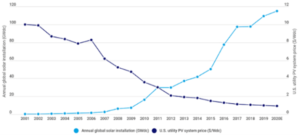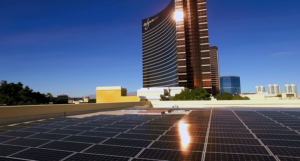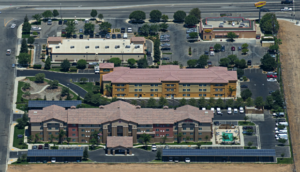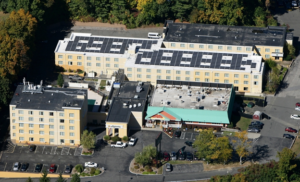Solar Powered Hotels!
Does solar energy save money and add value for hotels and resorts? PR-2/15/2020
In the US, total solar installations hit the one million mark in 2015. In May of 2019 total US Solar installations hit the two million mark. Total industry growth hit a staggering 120% in 2020 with more than 19 GWdc installed. As the solar market has expanded, the costs of installation have declined. Solar is now more cost-effective than ever and offers a number of compelling financial and environmental benefits for the hospitality industry as the technologies have been proven over
decades to be efficient, reliable, and affordable.
Annual Installations to Solar $/Wdc 
Hotels can reap the benefits of renewable energy in both the short and long terms. Lighting, HVAC and water heating accounts for approximately 60% of the total costs for a typical lodging facility. The U.S. Energy Star program estimates that hotels spent about $2,196 per room annually on energy alone. Hotels are eager to reduce their energy bills as well as their carbon footprints and business guests increasingly demand hotels be more sustainable.
Many hotels have invested in technology to reduce their power consumption. Whether it’s a switch to LED lighting, more efficient kitchen and laundry equipment, key cards which deactivate power in the room or movement sensors in corridors, there’s a wide array of actions that will shrink a property’s carbon footprint. But how many hotels look at the other end of the equation in terms of the origin of the power itself?
For many, a well-designed solar photovoltaic system can significantly lower energy bills while adding long term value. The hotels and resorts you’re about to see have installed a wide variety of solar energy systems. Some produce enough energy to completely eliminate their energy bills. Others produce enough for a partial reduction. Some have hundreds of rooms and large acreage. Others are smaller.
Wynn Resorts, Las Vegas – Offsetting 75% of Energy Bill
This huge resort, with 2716 rooms, built a 160-acre solar farm that will reduce their utility bills by 75%. With a fixed-cost 10-year financing deal, they will save 20% in energy just over that 10-year period.
After that, with the array fully paid for, each subsequent year will see dramatic cost savings.
Wynn Resorts plans to use these savings to invest in other energy saving technology, and to enhance their guest services. By re-investing their savings from solar, Wynn will be able to improve their resort’s bottom line even more.
Wynn Resorts Las Vegas uses two solar power facilities one on its rooftop and one that spans 160 acres offsite.
On June 29, 2020 Wynn Resorts (Nasdaq: WYNN) issued its 2019 Environmental, Social, and Governance (ESG) Report, providing a comprehensive view of the Company’s commitment to responsible business practices, environmental protection, and social impact.
Encore Boston Harbor opened with LEED Platinum certification and is the first resort in the world to achieve 100 percent renewable energy status by combining on-site power generation, battery storage, and the purchase of renewable energy credits.
Wynn Las Vegas ranked 9th on the list of top corporate solar installations in the U.S. according to the Solar Energy Industries Association.
Wynn Las Vegas debuted an eco-friendly 430,000-square-foot convention space expansion, and introduced the city’s first Zero Carbon, Zero Waste Event service
Source: www.hotelnewsnow.com/Articles/290305/The-ROI-of-solar-powered-hotels
Courtyard by Marriott-Lancaster – Now 100% Solar
This Pennsylvania hotel installed 2700 solar panels on the roof of the nearby Greenfield Corporate Center, enough to fill two football fields.
The hotel’s solar array will produce over 1.2 million kWh per year, just over the 1.18 million used by the hotel’s 133 rooms. The system cost $1.5 million to install. They saved 30% from the federal Investment Tax Credit, and $504,900 more from a grant through an in-state program.
With no utility bill, the hotel stands to see a great return on their investment.
For hotels, which typically have multiple stories and limited roof space, cancelling 100% of their electric bill through solar requires some creativity, and at times, some luck. In this case, the Courtyard was able to leverage a healthy relationship with the nearby Corporate Center and use their much larger roof area.

Hotel guests will be able to see the solar power produced in real-time on a new meter located in the lobby. Due to its size, more than twice as big as a football field, the roof top 2,700-panel array was placed on a warehouse about half a mile from the hotel.
Source: www.lodgingmagazine.com/high-hotels-invests-100-percent-solar-powered-hotel/
Hampton Inn, Bakersfield – Saving $8000 per Month
This Southern California 94-unit hotel used the same federal ITC to save 30% off their 102-kW solar energy system. Much smaller than the previous example, this hotel’s solar panels still produce over 13,000 kWh per month, which lowers its energy bills by 35-45%, depending on the time of year.
They’re now saving between $7400 and $8800 every month and expect to fully recover their investment in just 7.75 years.
In the photo, you’ll notice one creative way the Hampton was able to enlarge their solar array. Instead of using their roof, they built solar carports in sections of their parking lot. This actually removed the need to alter their roof at all.
However, had they wanted to, they could have installed an even larger system by also adding panels to their roof. But the creative use of carports simplified the installation process, and also provides a side benefit for their customers, who now have shaded parking right under the panels providing power for their rooms.
Cost of Carports in 2020 are in the range of most investors required IRR.
Source: www.greenhotelier.org/best-practice-sub/talking-point/whats-the-case-for-solar-powered-hotels/+
La Quinta Inn & Suites, Connecticut – 18% Solar Powered
Some hotels are more limited in their roof space, available land, or budget. But money saved is money saved. And the La Quinta in Danbury Connecticut will be saving $1500 on energy costs, every single month, from their 400-panel solar array.
The 113-unit hotel installed solar panels on two of their five buildings and are now generating 18% of their energy from solar power. That’s about one fifth. They’re also earning $16,000 per year in renewable energy credits. Every state offers different incentive programs, and Connecticut’s made solar a great opportunity for this La Quinta location.

The La Quinta Inn & Suites Danbury is embracing sustainability in a holistic way, and rooftop solar panels are just one of the hotel’s many green initiatives. “Being Green is something that impacts us financially, Our guests are looking for it so we see it on the top line but also it reduces utilities and other costs so more cash flows to the bottom line.” said Justin Jabara, MJH’s VP of development and acquisition.
Source: www.hotelmanagement.net/tech/how-solar-panels-generate-financial-savings
Is Your Hotel or Resort Suitable for Solar Power?
Hotels use far more energy than most other businesses with similar sized structures, because they must operate several power-hungry systems such as water heating, laundry, and HVAC, that service extensive square footage.
Thus, the potential is very high for saving large amounts of money even through a modestly sized solar array such as the La Quinta one.
Energy costs will only continue to rise, which makes the savings from solar power accelerate each year. Solar is inflation-proof energy production.
Key Considerations:
- Current Utility Costs.
- Available Incentives.
- State and Local Net Metering Policies.
- Installation Costs.
- Net Present Value of Financial Benefits.
- Intangible Benefits.
Measuring the value of going solar can be a complex and time-consuming undertaking, requiring both the collection of accurate and often unfamiliar information and its evaluation according to specialized methods. However, Avisi Energy possess the required methodological know-how to properly assess the value of investing in Solar and communicating its benefits. The above information particular to investments in solar energy are meant only to provide an understanding of the process.
